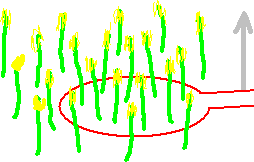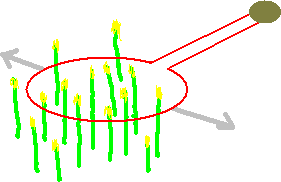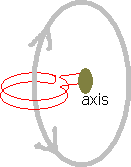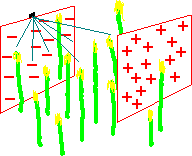1. IONS PUSHED TO ONE SIDE OF THE STALK
3. BOL'S IN VERTICAL MOTION - THE LORENTZ FORCE
4. BOL'S IN VERTICAL MOTION - PART 2
5. THE SUPERBOL AND ALTERNATING CURRENTS
7. EXPERIMENTS
13. MAGNETIC DUST SUCKED IN AND SPRAYED OUT
1. Simulation of a rising Ordinary BoL
A constant direct electric current runs through a conducting solid structure (red). It lies around some crop and there is crop around it. Suddenly the ring springs up to the sky.
Descending Ordinary BoL: from the sky the ring smashes down on the earth, around and between the crop.
One can vary the diameter of the ring, its spring-up acceleration and end velocity, current voltage and amperage.

 Fig. 7.1
Fig. 7.1
2. Simulation of an Ordinary BoL in horizontal motion
A constant direct electric current is running through the conducting solid structure (red). The structure rotates in the horizontal plane and hovers just over the crop while conducting electricity.
One can vary the diameter of the ring, its velocity, current voltage and amperage, height above the crop. Tilting the plane of the ring.

 Fig. 7.2
Fig. 7.2
3. Simulation of a rising or descending SuperBoL
A sample of crop grows in a bowl that is filled with some earth (black) and is mounted at a wall. An electricity conducting solid structure (red) rotates around an axis. The bowl is enveloped by the structure when it shoots by at each turn. There also grows some crop next to the rotating wire-structure.
One can vary the diameter of the ring, its velocity, current voltage and amperage, distance between the two red circles.
For reasons to be explained at a later page, the alternating part of the current not only suffices the equal phase, strength and direction
demand of Fig. 5.4, but it is also assumed that the phase is the same all over the circular wire too, at any moment. So for a proper SuperBoL simulation, it is not sufficient just to drive an alternating current through the wires. However, maybe it does not make too much difference for the outcome.



Fig. 7.3
4. Simulation of a BoL that emits electromagnetic radiation
Experiment: place the crop between two electrically opposite charged plates and radiates in with a microwave point source of one wavelength.
One can increase the volt per meter by increasing the charges or decreasing the distance between the plates. One can vary the location of the point source and its wavelength, or shift it to the other plate.

 Fig. 7.4
Fig. 7.4
These experiments should be decisive whether it is useful to set up computer simulation programs, whether it is worth the effort.